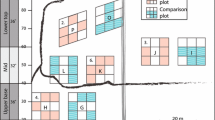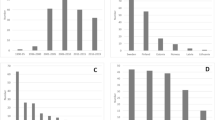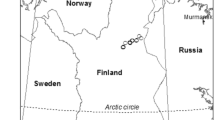Abstract
This paper details the processes and challenges involved in collecting inventory data from smallholder and community woodlots on Leyte Island, Philippines. Over the period from 2005 through to 2012, 253 woodlots at 170 sites were sampled as part of a large multidisciplinary project, resulting in a substantial timber inventory database. The inventory was undertaken to provide information for three separate but interrelated studies, namely (1) tree growth, performance and timber availability from private smallholder woodlots on Leyte Island; (2) tree growth and performance of mixed-species plantings of native species; and (3) the assessment of reforestation outcomes from various forms of reforestation. A common procedure for establishing plots within each site was developed and applied in each study, although the basis of site selection varied. A two-stage probability proportion to size sampling framework was developed to select smallholder woodlots for inclusion in the inventory. In contrast, community-based forestry woodlots were selected using stratified random sampling. Challenges encountered in undertaking the inventory were mostly associated with the need to consult widely before the commencement of the inventory and problems in identifying woodlots for inclusion. Most smallholder woodlots were only capable of producing merchantable volumes of less than 44 % of the site potential due to a lack of appropriate silviculture. There was a clear bimodal distribution of proportion that the woodlots comprised of the total smallholding area. This bimodality reflects two major motivations for smallholders to establish woodlots, namely timber production and to secure land tenure.






Similar content being viewed by others
Notes
A barangay is the smallest unit of local government in the Philippines and is approximately equivalent to a village.
In a previous study, some community members misinterpreted written consent as being a means of signing them up for membership of an insurgency group, and were unhappy about providing written consent (Cedamon and Emtage 2005).
Examples of recording sheets are provided in Supplementary Materials 1.
References
Baynes J (2005) The silvicultural of small-scale forest plantation in Leyte, the Philippines: a preliminary survey. In: Suh J, Harrison SR, Herbohn JL, Mangaoang EO and Vanclay JK (eds) ACIAR Smallholder Forestry Project ASEM/2003/052, Project Planning Workshop, Ormoc City, 15–17 February 2005
Baynes J (2007) Evaluating the effectiveness of a small-scale forest extension program on Leyte, Island, the Philippines.In: Harrison S, Bosch A and Herbohn J (eds) Improving the Triple Bottom Line Returns from Small-scale For, Proceedings from an International IUFRO 3.08 Conference, pp. 17–21 June 2007, Ormoc City
Baynes J, Garcia PP, Villamayor F, Gordon M (2007) Combining GIS and expert opinion to model landscapes for a smallholder forest extension program in Leyte, the Philippines. Ann Trop Res 29(1):49–66
Baynes J, Herbohn JL, Russell I (2009) Bringing agroforestry technology to farmers in Leyte, the Philippines: a comparison of two extension assistance. Small-scale For 8:381–398
Baynes J, Herbohn JL, Russell I (2011a) The influence of farmers’ mental models on an agroforestry extension program in the Philippines. Small-scale For 10:377–387
Baynes J, Herbohn JL, Russell I, Smith C (2011b) Bringing agroforestry technology to farmers’ in the Philippines: identifying constraints to the success of extension activities using systems modelling. Small-scale For 10:357–376
Carle J (2007) Vulnerabilities of smallholder plantings. Unasylva 228:58–59
Cedamon E (2012) Impacts of improved smallholder woodlot silviculture on yield, Profitability and Processing, PhD Thesis, The University of Queensland, Brisbane
Cedamon E, Emtage N (2005) Conducting surveys on forestry attitudes and practices in Leyte communities, Philippines: experiences and lessons learnt. Small-scale Forest Econ Manag Policy 4:69–84
Cedamon E, Harrison SR, Herbohn JL, Mangaoang E (2011) Compiling market and other financial data on smallholder forestry in Leyte, the Philippines. Small-scale For 10:149–162
Cedamon ED, Harrison S, Herbohn J (in press) Comparative analysis of on-site free-hand chainsaw milling and fixed site mini-bandsaw milling of smallholder timber. Small-scale For doi: 10.1007/s11842-012-9218-y
Coronas J (1920) The climate and the weather in the Philippines. Census AD, Manila
Dargantes B (1996) Socio-ecological Case Study on Forestlands Cultivation in Leyte, the Philippines, Verlag W and Koch S, Stuttgart
Dargusch P, Lawrence K, Herbohn J, Medrilzam (2010) A small-scale forestry perspective on constraints to including REDD in international carbon markets. Small-scale For 9:485–499
Göltenboth F, Hutter CP (2004) New options for land rehabilitation and landscape ecology in Southeast Asia by “rainforestation farming”. J Nat Conserv 12:181–189
Gregorio NO, Herbohn JL, Vanclay J (2012) Developing establishment guidelines for Shorea palosapis in smallholder plantings in the Philippines. Int For Rev 14:492–501
Harrison SR, Herbohn JL (2001) Evolution of small-scale forestry in the tropics. In: Harrison SR and Herbohn JL (eds) Sustainable farm forestry in the tropics: social and economic analysis and policy. Edward Elgar, Cheltenham, pp. 3–8
Harrison SR, Herbohn JL, Niskanen AJ (2002) Non-industrial, Smallholder, Small-scale and Family Forestry: what’s in a Name? Small-scale Forest Econ Manag Policy 1:1–11
Herbohn JL, Harrison SR, Vanclay J, Wardell-Johnson G (2005) Designing a strategy to sample tree farms on Leyte. In: Suh J, Harrison SR, Herbohn JL, Mangaoang EO and Vanclay J (eds) ACIAR Smallholder Forestry Project, ASEM/2003/052, Improving financial returns to smallholder tree farmer in the Philippines, Proceedings from the Planning Workshop held in Ormoc City, pp. 15–17 February 2005
Lamb D (2011) Regreening the bare hills: tropical forest restoration in the Asia-Pacific region. Springer, Dordrecht
Lantican CB, Piaz CP, Tandug CM (2005) Species-site compatibility assessment. CD-Rom. Ecosystems Research and Development Bureau, Department of Environment and Natural Resources, Los Baños
Snelder DJ, Lasco RD (2008) Smallholder tree growing for rural development and environmental services: lessons from Asia. Pages xxiii, p. 494 Springer, Dordrecht
Le HD, Smith C, Herbohn J, Harrison S (2012) More than just trees: assessing reforestation success in tropical developing countries. J Rural Stud 28:5–19
Mangaoang EO, Pasa AE (2003) Preferred native tree species for smallholder forestry in Leyte. Ann Trop Res 25(1):25–30
Margraf J, Milan P (1997) Ecology of Dipterocarp forests and its relevance for island rehabilitation in Leyte, Philippines. In: Schulte A, Schone D (eds) Dipterocarp forest ecosystems: towards sustainable management. World Scientific, Berlin, pp 124–154
Milan PP (1997a) Appraisal mission of rainforestation farming in Leyte. Visayas State College of Agriculture (ViSCA), Baybay
Milan PP (1997b) Strategy for community involvement in Rainforestation farming. In: International conference on reforestation with Philippine species for biodiversity protection and economic progress. Visayas College of Agriculture (ViSCA), GTZ, Leyte, p. 336
Milan PP, Ceniza MJC, Asio VB, Bulayog SB, Napiza MD (2004) Evaluation of silvicultural management, ecological change and market study of products of existing rainforestation demonstration and cooperators’ farms. Institute of Tropical Ecology, Baybay
Ngyuen H, Herbohn J, Firn J, Lamb D (2012) Biodiversity-production relationships in small-scale mixed-species plantations using native species in Leyte Province, Philippines. For Ecol Manage 274:81–90
Pulhin JM, Chokkalingam U, Peras RJJ, Acosta RT, Carandang AP, Natividad MQ, Lasco RD, Razal RA (2006) Historical overview. In: Chokkalingam U, Carandang AP, Pulhin JM, Lasco RD, Peras RJJ, Toma T (eds) One century of forest rehabilitation in the Philippines: approaches, outcomes and lessons. Centre for International Forestry Research, Bogor, pp 6–42
Schulte A (1998) Community-based rainforestation options for the Visayas, Philippines: a review. GTZ, Hoxter
Schulte A, (2002) Rainforestation Farming: option for rural development and biodiversity conservation in the humid tropics of Southeast Asia. A review of major issues on community-based rehabilitation silviculture and guide to recommended native tree species for the Visayas/Philippines. Shaker, Aachen
Thomas S, Dargusch P, Harrison S, Herbohn J (2010) Why are there so few afforestation and reforestation Clean Development Mechanism projects? Land Use Policy 27:880–887
Tomppo E, Heikkine J, Henttonen H, Ihalainen A, Katila M, Mäkelä H, Toumainen T, Vainikainen N (2011) Designing and conducting a forest inventory-case: 9th national forest inventory Finland. Springer, Dordretch
Vanclay JK, Baynes J (2005) Constructing a Yield Table for Smallholder Forests. In: Suh J, Harrison SR, Herbohn JL, Mangaoang EO and Vanclay JK (eds) ACIAR Smallholder Forestry Project ASEM/2003/052 improving financial returns to smallholder tree farmer in the Philippines, Proceedings from the Project Planning Workshop, Ormoc City, pp. 15–17 February 2005
Vanclay JK, Baynes J, Cedamon E (2008) Site index equation for smallholder plantations of Gmelina arborea in Leyte Province, the Philippines. Small-scale For 7:87–93
Acknowledgments
The authors would like to acknowledge the assistance of Dr Grant Wardell-Johnson in the design of sampling procedures and in the initial training of field staff. We are indebted to the team of excellent field workers who undertook this inventory, including Glen Monterola, Sammual Bernaldez, Chris Solano and Florante Morales. John Herbohn would like to acknowledge support provided by a Charles Bullard Fellowship at the Harvard Forest, Harvard University during which time much of the initial data analysis and manuscript preparation was undertaken. The authors would also like to acknowledge the useful comments made by two anonymous reviewers.
Author information
Authors and Affiliations
Corresponding author
Electronic supplementary material
Below is the link to the electronic supplementary material.
Rights and permissions
About this article
Cite this article
Herbohn, J.L., Vanclay, J., Ngyuen, H. et al. Inventory Procedures for Smallholder and Community Woodlots in the Philippines: Methods, Initial Findings and Insights. Small-scale Forestry 13, 79–100 (2014). https://doi.org/10.1007/s11842-013-9242-6
Accepted:
Published:
Issue Date:
DOI: https://doi.org/10.1007/s11842-013-9242-6




